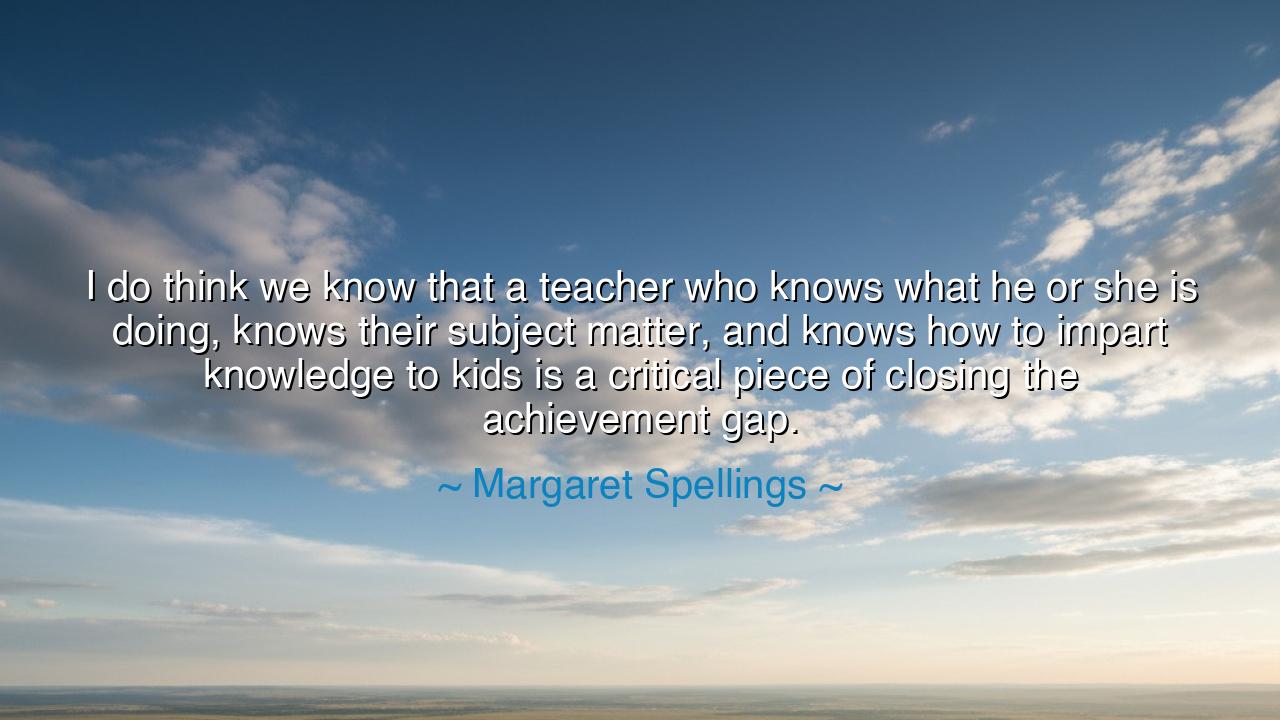
I do think we know that a teacher who knows what he or she is
I do think we know that a teacher who knows what he or she is doing, knows their subject matter, and knows how to impart knowledge to kids is a critical piece of closing the achievement gap.






“I do think we know that a teacher who knows what he or she is doing, knows their subject matter, and knows how to impart knowledge to kids is a critical piece of closing the achievement gap.” Thus spoke Margaret Spellings, former U.S. Secretary of Education, whose words resound with both urgency and hope. In this statement lies not only the recognition of the immense power of a teacher, but also the acknowledgment that education is the battlefield where the future of societies is won or lost. For the achievement gap—the distance between what some children can reach and what others are denied—is not a natural law, but a wound that must be healed. And the healer, above all, is the teacher who truly knows both their craft and their calling.
The meaning here is layered and profound. To “know what he or she is doing” is more than mastering techniques; it is to possess the wisdom of guidance. To “know their subject matter” is to hold not only facts but the living fire of knowledge. And to “impart knowledge” is not to pour information into passive minds, but to awaken curiosity, to stir imagination, to call forth the sleeping greatness of each child. A teacher who carries all three of these powers becomes more than an instructor; they become the bridge by which children cross from ignorance to possibility, from limitation to freedom.
History offers many mirrors of this truth. Think of Booker T. Washington, born into slavery yet rising to found Tuskegee Institute, where his mastery of knowledge and his ability to communicate it transformed generations. He did not merely teach the mechanics of farming and industry; he taught dignity, discipline, and vision. In his classrooms, the so-called “achievement gap” between the freed slave and the educated elite of America began to close. Washington embodied Spellings’ insight: that the right teacher, at the right time, can alter not just the fate of a student, but the course of a people.
It is also worth noting that the achievement gap is not only academic but spiritual and social. Where children are told, by circumstance or society, that they cannot rise, the gap becomes a chain around their souls. A great teacher breaks this chain. They speak not only of arithmetic and literature, but of potential, of dignity, of the vast horizon that every child deserves to see. They become prophets of possibility, declaring to each student: “You can. You will. You must.” Without such voices, inequality deepens; with them, the human spirit soars.
The heroism of teaching lies precisely here: in the refusal to allow talent to be buried by poverty, neglect, or prejudice. It is a battle fought not with weapons, but with chalk and patience, with lectures and encouragement. Many teachers will never see statues erected in their honor, but their legacy endures in the lives of students who go on to become scientists, leaders, healers, and dreamers. This is the hidden heroism that Spellings elevates—teachers as the critical key, the unseen warriors in the struggle against inequality.
The lesson for us is clear: if society would heal its divisions and close its gaps, it must invest in teachers. Let us honor them not with mere words, but with trust, support, and resources. And for those who walk the path of teaching: let these words be a reminder of your sacred charge. Do not teach only the subject; teach the soul. Do not merely recite knowledge; awaken it. Know your craft, know your material, but most importantly, know your students, for they are the future entrusted to your hands.
Therefore, dear listener, let us take practical action. Support schools not only with money but with presence—mentor, volunteer, encourage. Hold teachers in esteem, for they are builders of destiny. And if you are a teacher yourself, strive daily to grow in wisdom, mastery, and compassion. For it is not grand speeches nor lofty policies alone that close the achievement gap, but the steadfast labor of one teacher, in one classroom, reaching one child at a time—until the world itself is changed.
Thus we see that Margaret Spellings’ words are not simply policy talk but a timeless truth: that the true measure of a society’s greatness lies in how well it empowers its teachers, for in their hands rests the key to equality, to opportunity, and to the rising future of humankind.






AAdministratorAdministrator
Welcome, honored guests. Please leave a comment, we will respond soon